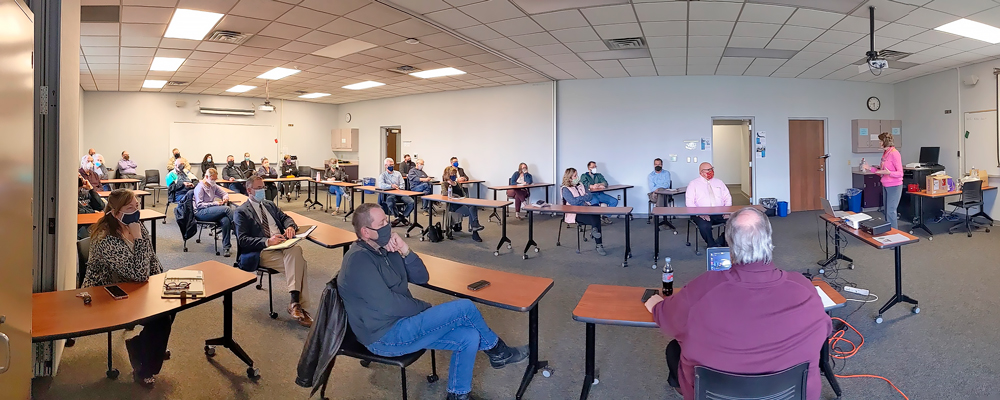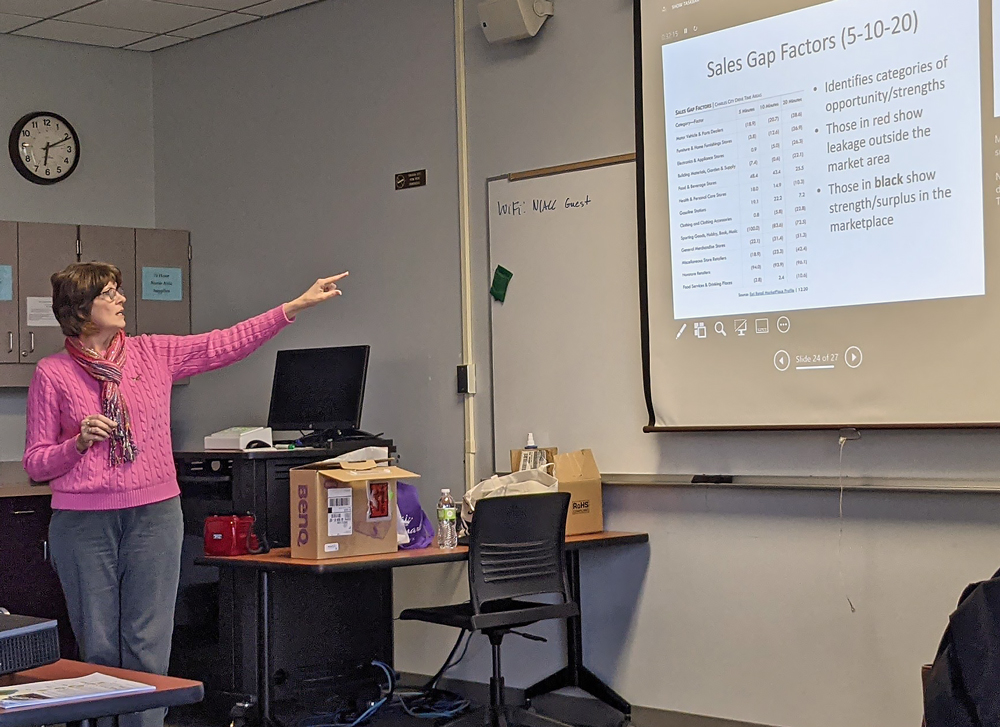Main Street business specialist lays out the data for Charles City



By Bob Steenson, bsteenson@charlescitypress.com
About 15,000 people live within 20 minutes driving time of Charles City. Those people are 51% female, have a median age of almost 45, are more than 91% white, have an average household income of almost $68,000 and most of them live in homes that they own.
Demographic information about the area workforce and shoppers — including what they’re buying in Charles City and areas where they could potentially be spending more money — was part of a presentation Tuesday evening by a business consultant with the Iowa Main Street program.
Business Specialist Robin Bostrom shared information from the latest economic profile on the Charles City community, using data from U.S. Census reports and from the Environmental Systems Research Institute (Esri).
“You guys are my second real-live audience in about a year,” she said, adding that she was so happy to see live faces, even if they were behind masks, rather than a computer screen.
Laying the groundwork for the figures she was about to present, Bostrom said the demographic data was based primarily on the 2010 Census, with some estimated updates, so it will be interesting to see how the numbers change when the 2020 Census information is released.
Also interesting, she suggested, will be the information that will be coming out on how the COVID-19 pandemic changed where and how people work, where and how they shop, and whether those changes are temporary or whether they have influenced long-term trends.
The typical Charles City-area household size is shrinking, with fewer children and a slightly older population, she said.
The median household income — the mark exactly halfway between the lowest income and the highest income — is slightly under the figure for Iowa and the nation as a whole, but the average household income is higher than the median, indicating there are more high-income earners who are pulling the local average up, she said.
There are 1,288 people who live and work in Charles City, Bostrom said, but more than 1,400 people who live in Charles City but work outside the city.
The biggest single category of workers — 2,311 — is those who are employed in Charles City but live outside the community.
That could be due to a number of factors, including the availability of housing in the community, Bostrom said.
The area has a higher-than average number of people who live in their own homes and a lower-than-average number of people who rent, which may be an indicator that there is a shortage of rental housing available.
A lot of people who start a job in a community want to rent their housing for a while, to make sure they like their job, and to get a feel for what the community has to offer and where they would like to live, she said.
If those people can’t find acceptable rental housing in the community where they are working they may look to rent elsewhere, and establish ties to that area.
One change that could work to Charles City’s advantage, Bostrom said, is what has happened to the workforce during the pandemic.
She said an estimated 16% to 20% of businesses are not going to bring their staffs back into the office once everything is open again. They have learned that their employees can be just as productive working from home and they can avoid the expense of maintaining office space.
Studies of new home plans show that 70% of them are including space for a home office, she said.
The fact the many employees no longer have to be concerned about living near where they work can mean communities like Charles City that have affordable housing, good schools, low crime and are still within two hours drive time from major metro areas can attract people who work from home — if there are homes or rentals available for them.
Looking at sales categories, the numbers show “leakage” in most categories, indicating that area shoppers are not spending what would be considered the average amount in those categories in Charles City, but are shopping elsewhere.
Food and beverage stores, health and personal care, gasoline stations and food services and drinking places all showed a “surplus,” meaning people were spending more than what would be considered the average in those categories in Charles City.
All the other categories that Esri tracks — motor vehicles and parts, furniture and home furnishings, electronics and appliances, building materials and garden and supply, clothing, sporting goods, general merchandise and miscellaneous store retailers — show “leakage,” Bostrom said.
The numbers provide useful information, she said, but they also have limitations. For example, some types of spending are not reported in the category that might be expected, for a variety of reasons.
Still, she said, the numbers can be used to identify opportunities for areas where the community could capture more spending dollars, and information about types of people who live in the area— called tapestry segments — can be valuable to understand the personality of potential customers.
For example, the Esri information identifies the area as “cozy country living,” and further divides that into “heartland communities” and “prairie living.”
Bostrom was invited to give the presentation by Charles City Main Street, and city Development Director Mark Wicks said the information she presented can be individually tailored to meet any businesses’ needs because Charles City is part of the Main Street Iowa program.









Social Share